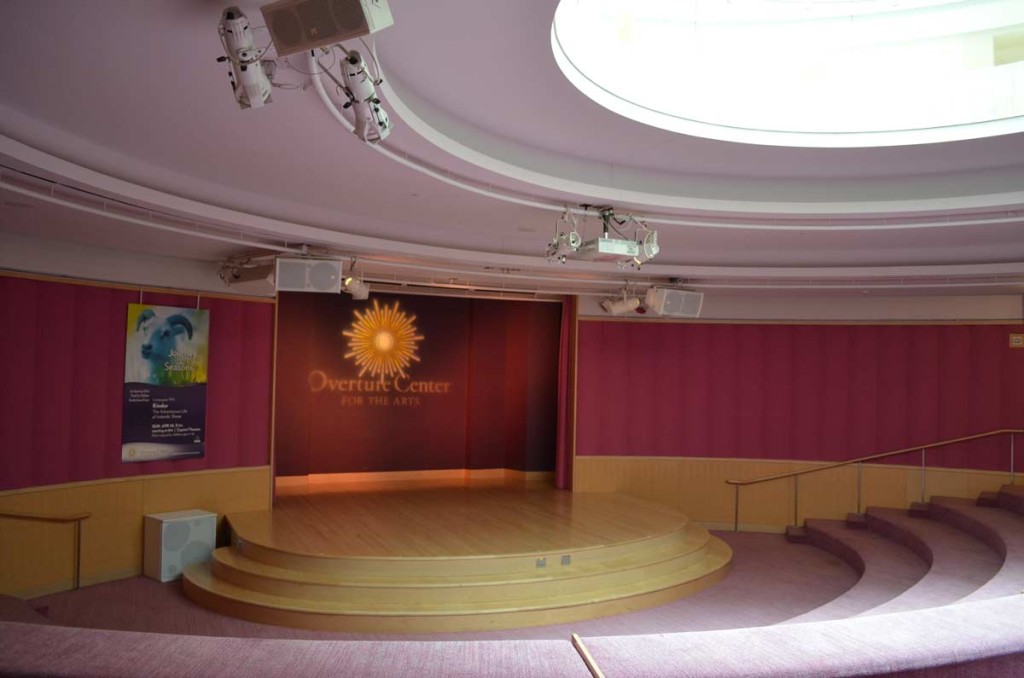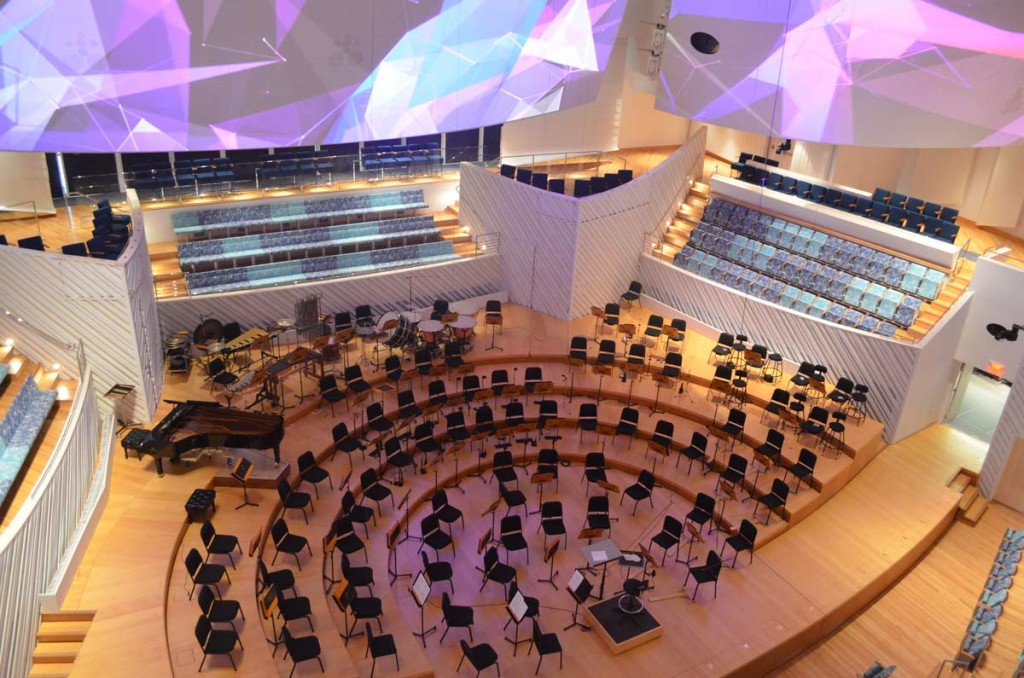Platform or Stage?
Is it a “stage” or a “platform”? While this seems an easy question to answer, it often is a source of confusion when designing a space for performance. The distinction is quite important, with far-ranging and often expensive consequences.

Small informal space at Overture Center for the Arts, Madison, WI. Example of a platform, not a stage. (Photo by author)
There are some minor differences in the definitions of each term between the International Building Code (IBC) and the Life Safety Code (NFPA 101). Each call a stage a “space within a building used for entertainment…” A platform, on the other hand, is defined as a “raised area within a building.” Each code definition goes on to describe the activities that may occur on a platform, citing examples such as entertainment, lecture, boxing rings, theatre in the round. The IBC definition then mentions that a platform does not have overhead hanging curtains. Interestingly, the Annex of NFPA 101 (A3.3.211) points out the platform requirements aren’t intended to restrict a modest number of curtains to hide services above. Of course, the definitions and annex information aren’t intended to be code, even if they are used by readers to interpret the requirements.
If you point to the floor on a stage, odds are most people will call it “stage.” Perhaps it’s better called the “stage floor.” The stage is a room, not just the floor part. But in the vernacular, the terms are interchangeable. No doubt almost every platform is called a “stage” by users. Additionally, stages (as in the room) often have platforms (a thing) installed upon them as scenery or risers. No wonder there’s confusion.

The concert hall at New World Symphony, Miami Beach, FL. A more complicated system, but this is a platform, no matter what people call it. (Photo by author)
Within the codes, the requirements for platforms are sparse. IBC (2015), in Section 410.4, states requirements for the construction of the platform. It addresses both permanent platforms and temporary platforms intended to remain in place for less than 30 days. NFPA 101 also addresses the construction of platforms in 12.4.6.2 (2015). Beyond that, there are no actual requirements for what happens on or above a platform. The platform is a thing built within another occupancy.
Stages are assumed to have much greater production capability. Stages are separated from the audience as another space, with robust fire protection requirements. If the stage exceeds 50-ft high from stage floor to underside of roof or the floor above, some sort of protection for the proscenium opening is required (fire safety curtain, deluge system, etc). That separation protects the audience, so they may egress safely should there be a fire in the stage. In all cases, a sprinkler system is needed. Above a certain size floor area, roof vents or mechanical ventilation are required on stages for both codes. IBC still requires standpipes, while NFPA 101 has eliminated the requirement in the 2018 version. Why all these additional requirements? The risk of fire due to the greater fuel load of curtains, scenery, lighting, etc… all packed into the stage area. But none of this is required for a platform plopped down in a room along with seats, such as a church, concert hall, or banquet room.

A view through the proscenium to the stage of the Palace Theatre, Cleveland, OH. Hard to argue this is anything but a stage. (Photo by author)
Both codes assume a platform within an assembly occupancy will have a limited amount of fire load, because there won’t be scenery, extensive curtains, and the like. Of course, we all know theatre people are nothing if not resourceful. The use of performance areas – whether a “stage” or a “platform” – can easily fall into gray areas. Just think of the forestage area, downstage of the proscenium where scenery may be found on the audience side of the opening; how is that handled? A church’s worship platform could be loaded with scenery for the annual Easter pageant. Owners, users, and code officials need to work together to address these questions.
The labeling of these areas adds to the challenge. Everyone from the contractor to the pastor to the bartender will call a platform a “stage.” But it’s not about the label, it’s in the use. Architects can help by properly identifying these areas on their drawings, but that only goes so far because it’s ultimately up to the interpretation of code officials. Of course, labeling a stage (i.e. room) a “platform” is no different than labeling an elephant an “eagle” – it’s not going to fly.
Codes are evolving in this area. ASTC considers code development to be one of the most critical parts of its mission.
By Paul G. Sanow, ASTC


